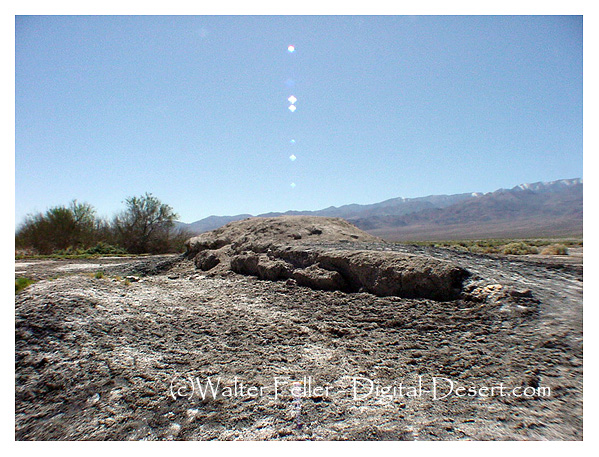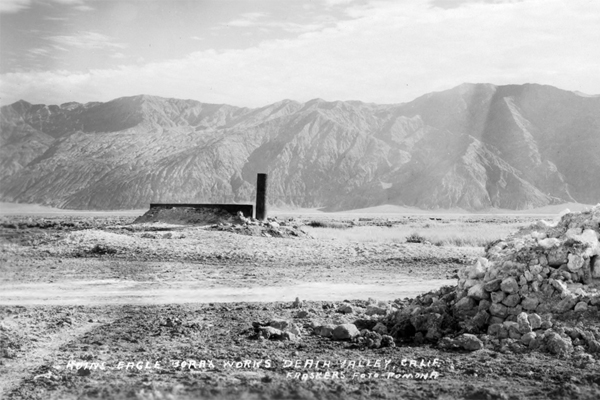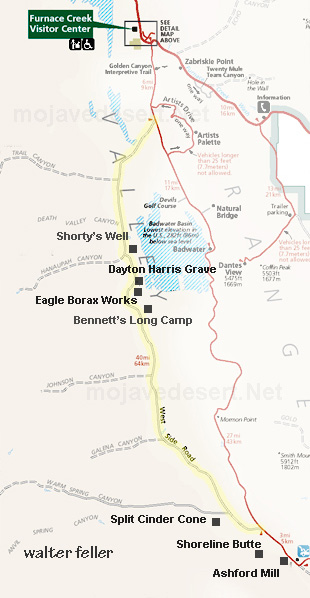Eagle Borax Works

Eagle Borax Works was the first borax refinery in Death Valley. Founded by Isadore Daunet, the works was producing by 1882. The inefficiency of the refineries' operation led to financial failure. It closed after two years, processing only 150 tons of relatively low grade ore.
History of Eagle Borax Works
In l880 Isidore Daunet and several companions attempted to cross Death Valley in the summer and became stranded, Daunet and a companion sought help and upon returning found 3 of those left behind dead from dehydration; at one point Daunet saved himself from the same fate by killing one of his animals and drinking its blood. On this adventure Daunet noticed the presence of borate in Death Valley.Daunet had migrated to this country from France in 1860 at the age of ten. He came to San Francisco and remained there until 1863 when he became a prospector. He had been prospecting in the Panamint Mountains when he and his six companions had made the unwise attempt to cross Death Valley in mid-summer.
In 1882 he entered into partnership with J.M. McDonald, M. Harmon, and C.C. Blanch to work in the borate field jst north of Bennetts Well. He hauled in the necessary machinery and equipment and set up operation, utilizing water from a nearby spring. Their first shipment, by wagon to the railhead at Daggett, of crudely refined borax, consisted of 37 tons, and brought but eight cents a pound, although one San Francisco authority considered it "about equal to the best refined article." But their technique apparently improved, and by the end of 1883, the partners had shipped a total of 260,000 pounds of borax, subsequent shipments of which had brought 10 cents and higher per pound.
The Eagle Borax claim consisted of 320 acres valued at $800 composed of 16 claims of 20 acres each. Improvements on the land were valued at $1000 in 1883 and $1,050 the following years.
The state mineralogist report that the product was hauled to Calico Station (Daggett) by way of Panamint Valley, Willow and Granite Spring, Black Ranch and Grapevine.
According to Ed Stiles in later years, he hauled the first load of borax from Eagle in the fall of 1882. When the freighting business dropped off to nothing because of the arrival of the railroad, a contract was entered with one of the agents for the borax operation to haul the refined borax to the railhead. Stiles was instructed to take a 12-nmle team and 2 wagons, one in tow, to the Death Valley site. Stiles hauled the plant's initial shipment which consisted of six tons of borax, taking 11 days to get to the railhead at Daggett. His wagons carried water which was replenished at springs along the way. Stiles said he hauled 4 of 5 loads for the Eagle Company before the freight company sold the wagons to W.T. Coleman, of Harmony Borax Works fame.
Daunet married Clotilde Gerraud on Oct. 1, 1882, and for a while his business and personal life went well. The plant in Death Valley continued to produce, and in May 1884, just before the roof fell in, reportedly employed 11 men who made enough borax to keep "three large teams steadily employed" transporting the product to the railhead. The plant operated continuously, except for the summer months when the weather was too hot to permit crystallization of the borax in the cooling vats.
 Eagle Borax Works 1928 - Frasher's Photos
Eagle Borax Works 1928 - Frasher's Photos
In May 1884, unfortunately business troubles began to pile up and Daunet's marriage deteriorated. After two men swindled him out of $11,000 and his wife served him divorce papers, Daunet put his pistol to his head. With the death of Daunet the business quickly folded and in time the property was sold. The land and property lay idle until 1901 when it was relocated as a mining claim and a few months later conveyed to U.S. Borax Company who held the site in their reserve borate lands until sold to Borax Consolidated LTD, in 1922. In 1956 the land was transferred to Death Valley Hotel Company and later conveyed to the National Park Service. Eagle Borax Works was the site of the first borax plant in Death Valley and the complex was a typical marsh-type operation, The works offers a valuable interpretive opportunity to display the pioneer beginnings of borax mining and processing in the United States which is so elosely related to Death Valley.
NATIONAL REGISTER OF HISTORIC PLACES INVENTORY
Southern Pacific Railroad - Mojave Desert
Between 1882 and 1883 borax ore was hauled from the Eagle Borax Works in Death Valley to Daggett. Borax was also hauled from William Coleman's ...Death Valley Photos
Eagle Borax Works. Eureka Dunes. Eureka Dunes rise nearly 680 feet above . ... Mustard Canyon. Yellow canyon near Harmony Borax Works. digital-desert.com/death-valley/death-valley-photo-tours.html The Strangest Farm in the World: White Heart of ... - Mojave Desert The road which crosses the valley below the ranch near the old Eagle Borax Works is said to be almost the only way to get over the swamp. The Panamint ...Chloride Cliff Ghost Town
In April of 1872, Franklin returned to his locations and began to work. ... used during the first years of borax mining at the Harmony and Eagle borax works.Furnace Creek/ Greenwater Valley & West Side Road Route Guide
The many short tunnels in these hills are borax prospects. ... Three miles north is the site of the Eagle Borax Works, where in the 1880s fifty men with high hopes ...